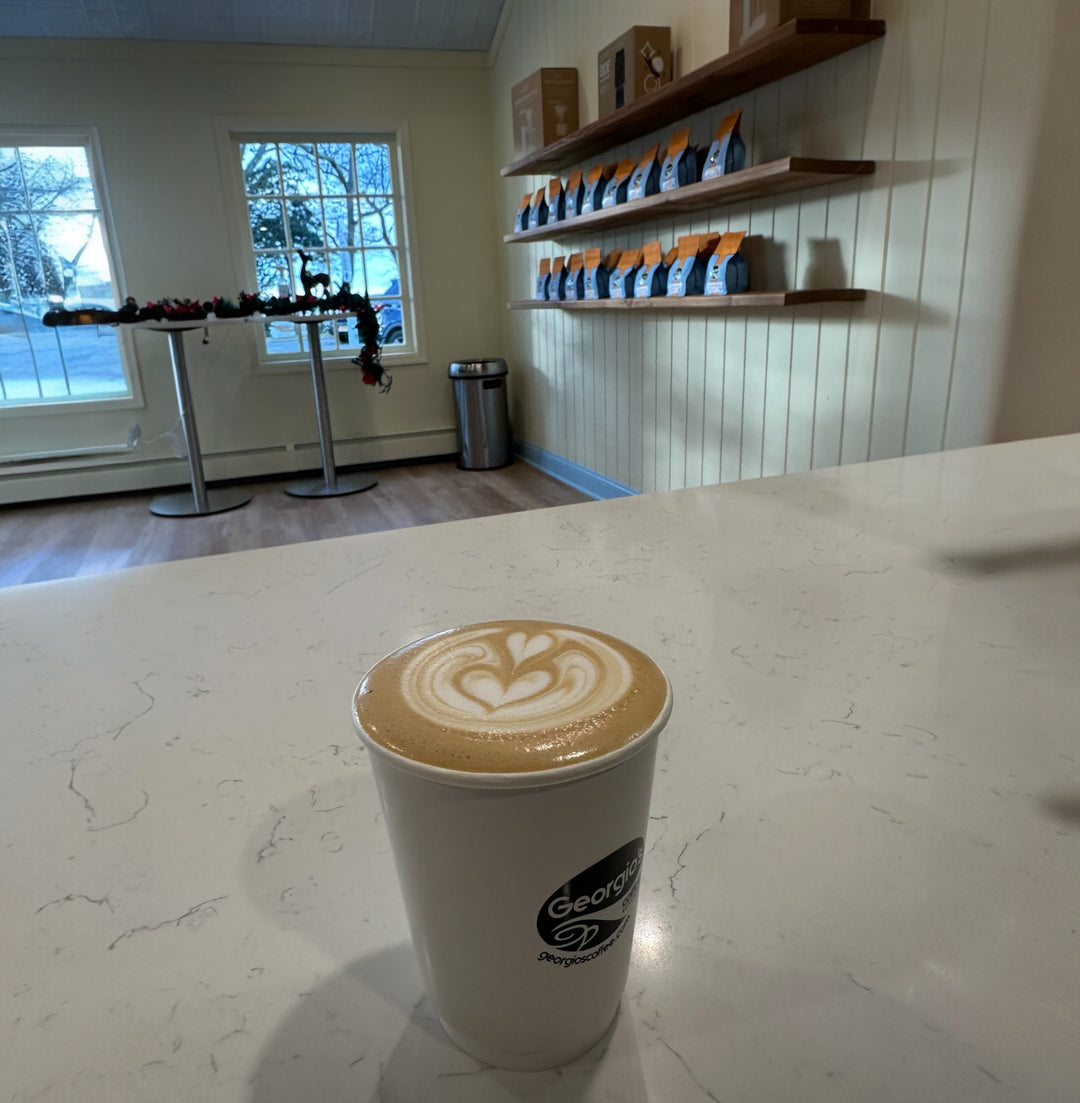How Do You Make Decaf Coffee

Do you ever wonder how decaf coffee is made? It's a fascinating process that involves several steps to remove the caffeine while preserving the delightful taste of coffee.
We will explore the intricate process of decaffeination, from soaking the beans to drying and roasting them. By understanding how decaf coffee is made, you'll gain a deeper appreciation for this popular beverage and its unique production method.
Decaffeination begins with soaking the coffee beans in water. This step helps to remove the caffeine from the beans, making them suitable for those who want to enjoy coffee without the stimulating effects of caffeine.
Next, a solvent, such as methylene chloride or ethyl acetate, is introduced to extract the caffeine from the beans. The solvent selectively binds to the caffeine molecules, separating them from the other compounds in the coffee beans. This process is carefully controlled to ensure that only the caffeine is removed, while the flavors and aromas of the coffee are preserved.
Once the caffeine has been extracted, the beans are rinsed to eliminate any residual chemicals. This thorough rinsing ensures that the final product is free from any traces of solvents or other potentially unwanted substances.
After rinsing, the beans are dried and roasted, just like regular coffee. This step helps to develop the unique flavors and aromas that we associate with coffee.
The end result is a delicious cup of decaf coffee that retains the character of its caffeinated counterpart, without the jolt of energy. So, the next time you sip on a cup of decaf coffee, you can appreciate the intricate process that went into making it caffeine-free while still delivering all the delightful flavors you love.
The Decaffeination Process: Soaking the Beans
Imagine yourself at a coffee processing plant, where you soak the coffee beans in water to begin the decaffeination process. As you carefully handle the beans, you can't help but marvel at the amount of work that goes into producing decaf coffee.
Soaking the beans is the first step in this intricate process that aims to remove most of the caffeine while preserving the flavor and aroma of the coffee. The soaking process is known as 'hydration' or 'swelling.' It involves immersing the green coffee beans in water, allowing them to absorb moisture. This step is crucial because it prepares the beans for the next stage of decaffeination.
The moisture causes the cells in the beans to expand, making it easier for the caffeine to be extracted later on. The duration of the soaking can vary depending on the desired level of decaffeination, but it typically lasts between 8 to 12 hours.
During the soaking process, the water acts as a solvent, pulling out the caffeine from the beans. However, it's important to note that water alone cannot remove all the caffeine. To enhance the extraction, coffee processors often add other substances to the water, such as ethyl acetate or methylene chloride. These solvents help to dissolve the caffeine and facilitate its removal.
Once the soaking is complete, the beans are thoroughly rinsed to remove any leftover solvents, ensuring that only trace amounts of them remain in the final product.
Soaking the coffee beans in water is the first step in the decaffeination process. This crucial stage prepares the beans for the extraction of caffeine while preserving the coffee's flavor and aroma. By immersing the beans in water and allowing them to absorb moisture, the cells expand, making it easier for the caffeine to be removed. Adding solvents to the water further enhances the extraction, ensuring a high-quality decaf coffee that can be enjoyed by coffee lovers who want to limit their caffeine intake.
Introducing the Solvent: Methylene Chloride or Ethyl Acetate
To truly appreciate the intricate process of crafting decaffeinated coffee, picture yourself immersed in the world of solvents, where the dance of methylene chloride or ethyl acetate takes center stage. These solvents play a crucial role in removing caffeine from the coffee beans while preserving the desired flavors.
Methylene chloride and ethyl acetate are two commonly used solvents in the decaffeination process. Methylene chloride, also known as dichloromethane, is a colorless liquid that efficiently extracts caffeine from the coffee beans. It has a low boiling point, which makes it easy to remove from the beans after the decaffeination process is complete. Methylene chloride is effective at selectively dissolving caffeine while leaving the other desirable compounds intact, ensuring that the flavor and aroma of the coffee are preserved.
Ethyl acetate, on the other hand, is a natural solvent derived from fruits such as apples and oranges. It is widely used in the food industry and is considered safe for consumption. Ethyl acetate decaffeination involves soaking the coffee beans in water and then introducing ethyl acetate to extract the caffeine. The solvent binds with the caffeine molecules, and the mixture is then heated to remove the ethyl acetate, leaving behind decaffeinated coffee beans with minimal loss of flavor.
The use of solvents such as methylene chloride and ethyl acetate is an essential step in the decaffeination process. These solvents selectively remove caffeine from the coffee beans while preserving the flavor and aroma that coffee enthusiasts enjoy. Whether it's the efficiency of methylene chloride or the natural extraction properties of ethyl acetate, the dance of solvents ensures that decaf coffee can be enjoyed by those who desire a caffeine-free cup without compromising on taste.
Rinsing to Remove Residual Chemicals
As you rinse the coffee beans, residual chemicals are effectively removed, ensuring a clean and pure final product. This step is crucial in the decaffeination process as it helps to eliminate any remaining traces of the solvent used to extract caffeine from the beans.
After the initial extraction, the beans are thoroughly washed with water to flush out any methylene chloride or ethyl acetate that may still be clinging to the surface. This rinsing process is repeated multiple times to ensure that all residual chemicals are completely removed.
During the rinsing stage, the coffee beans are typically soaked in water for a specific period of time. This allows the water to penetrate the beans and dissolve any remaining solvent molecules. The length of time for the rinsing process may vary depending on the specific decaffeination method used and the desired level of decaffeination. However, it's important to note that excessive rinsing can also result in the loss of desirable flavor compounds, so finding the right balance is key.
Additionally, water quality and temperature play important roles in the rinsing process. The water used for rinsing should be of high quality to avoid introducing any impurities into the beans. The temperature of the water should be carefully controlled as well, as different temperatures can affect the extraction of flavor compounds.
By rinsing the coffee beans thoroughly and using appropriate water conditions, the decaffeination process can effectively remove any residual chemicals, ensuring a clean and pure final product.
The rinsing step is a critical part of the decaffeination process, allowing for the removal of residual chemicals from the coffee beans. Through multiple rinses with water, any remaining traces of the solvent used to extract caffeine are effectively eliminated. Careful consideration of water quality and temperature is necessary to maintain the integrity of the flavor compounds in the beans.
By following these procedures, a clean and pure decaf coffee can be produced, ready to be enjoyed by those seeking a caffeine-free option.
Drying and Roasting the Beans
The next step in the process is to dry and roast the beans, which brings out the rich flavors and aromas that are beloved by coffee enthusiasts. After the beans have been rinsed to remove any residual chemicals, they are carefully dried to ensure optimal moisture content.
This step is crucial in preventing the growth of mold and bacteria while also preserving the flavor of the beans.
Once the beans have been dried, they are ready for roasting. Roasting is a delicate process that requires careful temperature control and precise timing. The beans are heated to high temperatures, causing them to undergo a complex series of chemical reactions.
This process caramelizes the sugars in the beans, giving them their characteristic flavor and aroma.
During the roasting process, the beans are constantly monitored to ensure that they are roasted to perfection. The length of the roast can vary depending on the desired flavor profile, with lighter roasts preserving more of the bean's natural flavors and darker roasts developing bolder, smokier notes.
After the beans have been roasted to the desired level, they are allowed to cool before being packaged and sent out to coffee lovers around the world.
The drying and roasting process is a crucial step in the creation of decaf coffee. It not only removes any residual chemicals from the beans but also brings out the rich flavors and aromas that make coffee so enjoyable.
With careful temperature control and precise timing, the beans are roasted to perfection, resulting in a delicious cup of decaf coffee that's loved by many.
Enjoying the Delightful Taste of Decaf Coffee
Indulge in the exquisite flavor of a perfectly brewed cup of decaf, and let your taste buds dance with delight. Despite the absence of caffeine, decaf coffee still offers a delightful taste that can rival its caffeinated counterpart.
The process of decaffeination, which extracts the caffeine from the coffee beans, does not compromise the rich and complex flavors that coffee lovers crave. In fact, decaf coffee can surprise even the most discerning palates with its smooth and nuanced taste.
To create decaf coffee, the green coffee beans are first soaked in water to soften the outer layer. Then, a solvent or water is used to extract the caffeine from the beans. This process is carefully controlled to ensure that only the caffeine is removed, leaving the flavors intact. After the decaffeination process, the beans are dried and roasted to perfection, bringing out the unique characteristics of each bean.
The result is a cup of decaf coffee that boasts a balanced and full-bodied flavor. The absence of caffeine allows the natural flavors of the coffee beans to shine through, offering a pure and unadulterated taste. Whether you prefer a bold and robust brew or a smooth and mellow cup, decaf coffee can cater to your preferences.
So go ahead, savor the delightful taste of decaf coffee and let your taste buds revel in its exquisite flavors.
Making Decaf Coffee
So there you have it, a detailed explanation of how decaf coffee is made. You now know that the decaffeination process involves soaking the beans to remove the caffeine, and then introducing a solvent such as methylene chloride or ethyl acetate.
The beans are then rinsed to remove any residual chemicals and finally dried and roasted to perfection.
Decaf coffee may not have the same level of caffeine as regular coffee, but it certainly doesn't lack in flavor. In fact, many people find the taste of decaf coffee to be just as delightful as its caffeinated counterpart.
So the next time you're in the mood for a cup of coffee but want to avoid the jitters, reach for a decaf option and savor the rich, smooth flavors without the caffeine kick.
Understanding how decaf coffee is made can also give you a greater appreciation for the process and the effort that goes into creating a satisfying cup of decaf. So the next time you sip on your decaf brew, take a moment to reflect on the meticulous steps involved in producing that perfect cup.
Whether you choose to enjoy decaf for health reasons or simply because you prefer the taste, rest assured that your cup of decaf coffee is the result of a carefully crafted process that brings out the best in every bean.







